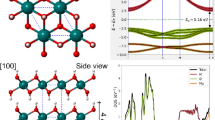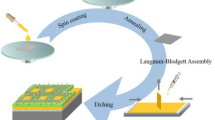Abstract
A model of a nanoscale dielectric capacitor composed of a few dopants has been investigated in this study. This capacitor includes metallic graphene layers which are separated by an insulating medium containing a few h-BN layers. It has been observed that the elements from group IIIA of the periodic table are more suitable as dopants for hetero-structures of the {metallic graphene/hBN/metallic graphene} capacitors compared to those from groups IA or IIA. In this study, we have specifically focused on the dielectric properties of different graphene/h-BN/graphene including their hetero-structure counterparts, i.e., Boron-graphene/h-BN/Boron-graphene, Al-graphene/h-BN/Al-graphene, Mg-graphene/h-BN/Mg-graphene, and Be-graphene/h-BN/Be-graphene stacks for monolayer form of dielectrics. Moreover, we studied the multi dielectric properties of different (h-BN)n/graphene hetero-structures of Boron-graphene/(h-BN)n/Boron-graphene.

Graphene plates composed with two boron nitride–graphene as an insulator



Similar content being viewed by others
Notes
In the CHELPG (Charges from Electrostatic Potentials using a Grid based method), atomic charges are fitted to reproduce the molecular electrostatic potential (MESP at a number of points around the molecule. The MESP is calculated at a number of grid points spaced 3.0 pm apart and distributed regularly in a cube. Charges derived in this way don’t necessarily reproduce the dipole moment of the molecule. CHELPG charges are frequently considered superior to Mulliken charges as they depend much less on the underlying theoretical method used to compute the wave function (and thus the MESP).
References
Ostinga JB, Heersche HB, Liu X, Morpuzo AF, Vanderspyen LMK (2008) Gate-induced insulating state in bilayer graphene devices. Nat Mater 7:151–157
Dressalhaus MS, Dresselhaus G, Eklunch PC (1995) Academic, San Diego
Tanuma S, Kanimura H (1985) Overview on the progress of graphite intercalation compound research project. Progress of research in Japan. World Scientific, Singapore
Castro Neto AH, Guinea F, Peres NMR, Novoselov KS, Geim AK (2009) The electronic properties of graphene. Rev Mod Phys 81(1):109
Geim AK, Novoselov KS (2007) The rise of graphene. Nat Mater 6(3):183–191
Yildirim T, Ciraci S (2005) Titanium-decorated carbon nanotubes as a potential high-capacity hydrogen storage medium. Phys Rev Lett 94:175501
Durgun E, Ciraci S, Zhou W, Yildirim T (2006) Transition-metal-ethylene complexes as high-capacity hydrogen-storage media. Phys Rev Lett 97:226102
Liu Z, Song L, Zhao SZ, Huang JQ, Ma LL, Zhang JN, Lou J, Ajayan PM (2011) Direct growth of graphene/hexagonal boron nitride stacked layers. Nano Lett 11:2032–2037
Özçelik VO, Cahangirov S, Ciraci S (2012) Epitaxial growth mechanisms of graphene and effects of substrates. Phys Rev B 85:235456
Sachs B, Wehling TO, Katsnelson MI, Lichtenstein AI (2011) Adhesion and electronic structure of graphene on hexagonal boron nitride substrates. Phys Rev B 84:195414
Monajjemi M, Boggs JE (2013) A new generation of BnNn rings as a supplement to boron nitride tubes and cages. J Phys Chem A 117:1670–1684. doi:10.1021/jp312073q
Ataca C, Ciraci S (2011) Perpendicular growth of carbon chains on graphene from first-principles. Phys Rev B 83:235417
Chan KT, Lee H, Cohen ML (2011) Gated atoms on graphene studied with first-principles calculations. Phys Rev B 83:035405
Chan KT, Lee H, Cohen ML (2011) Phys Rev B 84:165419
Suarez AM, Radovic LR, Bar-Ziv E, Sofo JO (2011) Gate-voltage control of oxygen diffusion on graphene. Phys Rev Lett 106:146802
Topsakal M, Ciraci S (2012) Effects of static charging and exfoliation of layered crystals. Phys Rev B 85:045121
Shi G, Hanlumyuang Y, Liu Z, Gong Y, Gao W, Li B, Kono J, Lou J, Vajtai R, Sharma P, Pulickel M, Ajayan PM (2014) Boron nitride–graphene nano-capacitor and the origins of anomalous size-dependent increase of capacitance. Nano Lett 14:1739–1744
Ozcelik VO, Ciraci SJ (2013) Size dependence in the stabilities and electronic properties of α-graphyne and its boron nitride analogue. Phys Chem C 117(5):2175–2182
Dion M, Rydberg H, Schroder E, Langreth DC, Lundqvist BI (2004) Van der Waals density functional for general geometries. Phys Rev Lett 92:24640
Monajjemi M (2013) Non bonded interaction between BnNn (stator) and image (rotor) systems: a quantum rotation in IR region. Chem Phys 425:29–45
Gao M, Lyalin A, Taketsugu TJ (2012) Catalytic activity of Au and Au2 on h-BN surface adsorption and activation of O2. Phys Chem 116:9054–9062. doi:10.1021/jp300684v#_blank
Paszkowicz W, Pelka JB, Knapp M, Szyszko T, Podsiadlo S (2002) Lattice parameters and anisotropic thermal expansion of hexagonal boron nitride in the 10–297.5 K temperature range. Appl Phys A 75(3):431–435
Hamada I, Otani M (2010) Comparative van der Waals density-functional study of graphene on metal surfaces. Phys Rev B 82:153412
Liu Z, Zhan YJ, Shi G, Moldovan S, Gharbi M, Song L, Ma LL, Gao W, Huang JQ, Vajtai R, Banhart F, Sharma P, Lou J, Ajayan PM (2012) Anomalous high capacitance in a coaxial single nanowire capacitor. Nat Commun 3:879
Liu Z, Ma LL, Shi G, Zhou W, Gong YJ, Lei SD, Yang XB, Zhang JN, Yu JJ, Hackenberg KP, Babakhani A, Idrobo JC, Vajtai R, Lou J, Ajayan PM (2013) In-plane heterostructures of graphene and hexagonal boron nitride with controlled domain sizes. Nat Nanotechnol 8(2):119–124
Macucci M (1997) Differential capacitance between circular stacked quantum dots. Phys E 1:7–14
Macucci M, Hess K, Iafrate GJ (1993) Electronic energy spectrum and the concept of capacitance in quantum dots. Phys Rev B 48:17354–17363
Wang B, Zhao X, Wang J, Guo H (1999) Nonlinear quantum capacitance. Appl Phys Lett 74:2887–2889
Wang J et al (1998) Capacitance of atomic junctions. Phys Rev Lett 80:4277–4280
Mulak J (1996) The Thomas–Fermi type screening of the crystal field multipole moments. J Solid State Chem 124:182–189
Ashcroft NW, Mermin ND (1976) Solid state physics. Saunders College Publishing, Philadelphia
Schmidt MW, Baldridge KK, Boatz JA, Elbert ST, Gordon MS, Jensen JH, Koseki S, Matsunaga N, Nguyen KA et al (2004) General atomic and molecular electronic structure system. J Comput Chem 14(11):1347–1363. doi:10.1002/jcc.540141112
Zhao Y, Truhlar DG (2008) The M06 suite of density functionals for main group thermochemistry, thermochemical kinetics, noncovalent interactions, excited states, and transition elements: two new functionals and systematic testing of four M06-class functionals and 12 other functionals. Theory Chem Account 120:215–241. doi:10.1007/s00214-007-0310-x
Zhao Y, Truhlar DG (2008) Density functionals with broad applicability in chemistry. Acc Chem Res 41(2):157–167
Monajjemi M, Jafari Azan M, Mollaamin F (2013) Density functional theory study on B30N20 nanocage in structural properties and thermochemical outlook. Fuller Nanotub Car N 21(6):503–515
Grimme S (2006) Seemingly simple stereo electronic effects in alkane isomers and the implications for Kohn–Sham density functional theory. Angew Chem Int Ed 45:4460–4464. doi:10.1002/anie.200600448
Monajjemi M, Seyed Hosseini M, Molaamin F (2013) Theoretical study of boron nitride nanotubes with armchair forms. Fuller Nanotub Car N 21(5):381–393
Schreiner PR, Fokin AA, Pascal RA Jr, de Meijere A (2006) Many density functional theory approaches fail to give reliable large hydrocarbon isomer energy differences. Org Lett 8:3635–3638
Zhao Y, Truhlar DG (2006) A density functional theory that accounts for medium-range correlation energies in organic chemistry. Org Lett 8:5753–5755
Ao Z, Yang J, Li S, Jiang Q (2008) Enhancement of CO detection in Al doped graphene. ChemPhys Lett 461(4):276–279
Kohn W, Sham LJ (1965) Self-consistent equations including exchange and correlation effects. Phys Rev 140:A1133–A1138
Perdew JP, Burke K, Ernzerhof (1996) Generalized gradient approximation made simple. Phys Rev Lett 77:3865–3868
Blöchl PE, Jepsend O, Andersen OK (1994) Improved tetrahedron method for Brillouin-zone integrations. Phys Rev B 49:16223
Besler BH, Merz KM, Kollman PA (1990) Atomic charges derived from semi empirical methods. J Comput Chem 11:431–439. doi:10.1002/jcc.540110404
Chirlian LE, Francl MM (1987) Atomic charges derived from electrostatic potentials: a detailed study. J Comput Chem 8:894–905. doi:10.1002/jcc.540080616
Brneman GM, Wiberg KB (1990) J Comput Chem 11:361
This approach (CHELPG) is shown to be considerably less dependent upon molecular orientation than the original CHELP program. The results are compared to those obtained by using CHELP
Martin F, Zipse H (2005) Charge distribution in the water molecule — a comparison of methods. J Comput Chem 26:97–105
Monajjemi M, Lee VS, Khaleghian M, Honarparvar B, Mollaamin F (2010) Theoretical description of electromagnetic nonbonded interactions of radical, cationic, and anionic NH2BHNBHNH2 inside of the B18N18 nano ring. J Phys Chem C 114:15315
Monajjemi M, Khaleghian M (2011) EPR study of electronic structure of [CoF6] and B18N18 nano ring field effects on octahedral complex. J Clust Sci 22:673–692. doi:10.1007/s10876-011-0414-2
Monajjemi M (2012) Quantum investigation of non-bonded interaction between the B15N15 ring and BH2NBH2 (radical, cation, anion) systems: a nano molecular motor. Struct Chem 23:551
Balderchi A, Baroni S, Resta R (1998) Phys Rev Lett 61:173
Politzer P, Lane P, Murray JS, Concha MC (2005) Comparative analysis of surface electrostatic potentials of carbon, boron/nitrogen and carbon/boron/nitrogen model nanotubes. J Mol Model 1(11):1–7
Author information
Authors and Affiliations
Corresponding author
Rights and permissions
About this article
Cite this article
Monajjemi, M. Metal-doped graphene layers composed with boron nitride–graphene as an insulator: a nano-capacitor. J Mol Model 20, 2507 (2014). https://doi.org/10.1007/s00894-014-2507-y
Received:
Accepted:
Published:
DOI: https://doi.org/10.1007/s00894-014-2507-y




